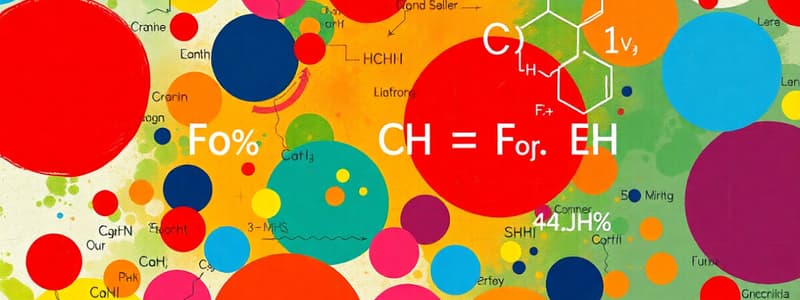Podcast
Questions and Answers
What defines the ratio between the molecular formula and the empirical formula of a compound?
What defines the ratio between the molecular formula and the empirical formula of a compound?
- M compound/MEF = X (correct)
- Empirical percentage
- Chemical reactivity
- Molecular weight distribution
Under what condition are the molecular and empirical formulas of a compound identical?
Under what condition are the molecular and empirical formulas of a compound identical?
- When they contain no atoms
- When the compound is a simple ion
- When they include at least one element
- When dividing results in a whole number (correct)
Why can two compounds have the same percentage composition but different molecular masses?
Why can two compounds have the same percentage composition but different molecular masses?
- They have different chemical bonds
- They are made of different isotopes
- They contain a different number of atoms of each element (correct)
- They have variable temperature conditions
What does stoichiometry describe in chemical reactions?
What does stoichiometry describe in chemical reactions?
How are mole ratios utilized in gravimetric stoichiometry?
How are mole ratios utilized in gravimetric stoichiometry?
What represents the lowest whole number ratio of atoms in a compound?
What represents the lowest whole number ratio of atoms in a compound?
How do the empirical and molecular formulas differ when they represent the same compound?
How do the empirical and molecular formulas differ when they represent the same compound?
Do compounds with the same empirical formula always exhibit identical properties?
Do compounds with the same empirical formula always exhibit identical properties?
According to the Law of Definite Proportions, what can be said about the composition of a compound?
According to the Law of Definite Proportions, what can be said about the composition of a compound?
Which of the following is a correct formula for determining the percent of an element in a compound?
Which of the following is a correct formula for determining the percent of an element in a compound?
What is the function of the limiting reagent in a chemical reaction?
What is the function of the limiting reagent in a chemical reaction?
What is the formula for calculating percentage yield?
What is the formula for calculating percentage yield?
Which of the following is NOT a common factor affecting actual yield?
Which of the following is NOT a common factor affecting actual yield?
What does actual yield refer to in a chemical reaction?
What does actual yield refer to in a chemical reaction?
In a chemical reaction, what is an excess reagent?
In a chemical reaction, what is an excess reagent?
What is the primary function of a mole in chemistry?
What is the primary function of a mole in chemistry?
What does Avogadro's Constant (Na) represent?
What does Avogadro's Constant (Na) represent?
How is the number of moles calculated from mass and molar mass?
How is the number of moles calculated from mass and molar mass?
What does the Law of Definite Proportions state regarding elements in a compound?
What does the Law of Definite Proportions state regarding elements in a compound?
What does percent composition represent in a compound?
What does percent composition represent in a compound?
Flashcards
Percent element
Percent element
The percentage of a specific element's mass within a compound.
Empirical Formula
Empirical Formula
Simplest whole number ratio of atoms in a compound.
Molecular Formula
Molecular Formula
Exact composition of a molecule in a compound.
Same empirical formula, different properties?
Same empirical formula, different properties?
Signup and view all the flashcards
Law of Definite Proportions
Law of Definite Proportions
Signup and view all the flashcards
Molecular vs. Empirical Formula
Molecular vs. Empirical Formula
Signup and view all the flashcards
Same Percentage Composition, Different Molecular Formula?
Same Percentage Composition, Different Molecular Formula?
Signup and view all the flashcards
Gravimetric Stoichiometry
Gravimetric Stoichiometry
Signup and view all the flashcards
Mole Ratios
Mole Ratios
Signup and view all the flashcards
Predicting Mass Amounts
Predicting Mass Amounts
Signup and view all the flashcards
Limiting Reagent
Limiting Reagent
Signup and view all the flashcards
Excess Reagent
Excess Reagent
Signup and view all the flashcards
Theoretical Yield
Theoretical Yield
Signup and view all the flashcards
Actual Yield
Actual Yield
Signup and view all the flashcards
Percentage Yield
Percentage Yield
Signup and view all the flashcards
What is a mole?
What is a mole?
Signup and view all the flashcards
What is Avogadro's Constant?
What is Avogadro's Constant?
Signup and view all the flashcards
Moles, particles, and Avogadro's Constant
Moles, particles, and Avogadro's Constant
Signup and view all the flashcards
Atomic Mass = Molar Mass
Atomic Mass = Molar Mass
Signup and view all the flashcards
Moles, mass, and molar mass
Moles, mass, and molar mass
Signup and view all the flashcards
Study Notes
Percentage Composition
- Percentage composition is the percentage by mass of each element in a compound
- Elements in a compound are always in the same proportions by mass, following the Law of Definite Proportions
Empirical Formulas
- Empirical formula gives the lowest whole number ratio of atoms in a compound.
- Example: H₂O, CH
Molecular Formulas
- Molecular formula gives the exact composition of 1 molecule of a compound.
- Example: C₂H₆, C₆H₁₂
- Molecular formula = empirical formula when the subscripts are the lowest value
Comparing Compounds with the Same Empirical Formula
- Compounds with the same empirical formula have the same percentage composition but different molecular masses because the number of atoms of each element is different in each compound.
- Example: N₂O₄, N₂O and H₂O₂ have the same properties.
- No compounds have different properties (because they are different compounds).
Studying That Suits You
Use AI to generate personalized quizzes and flashcards to suit your learning preferences.




